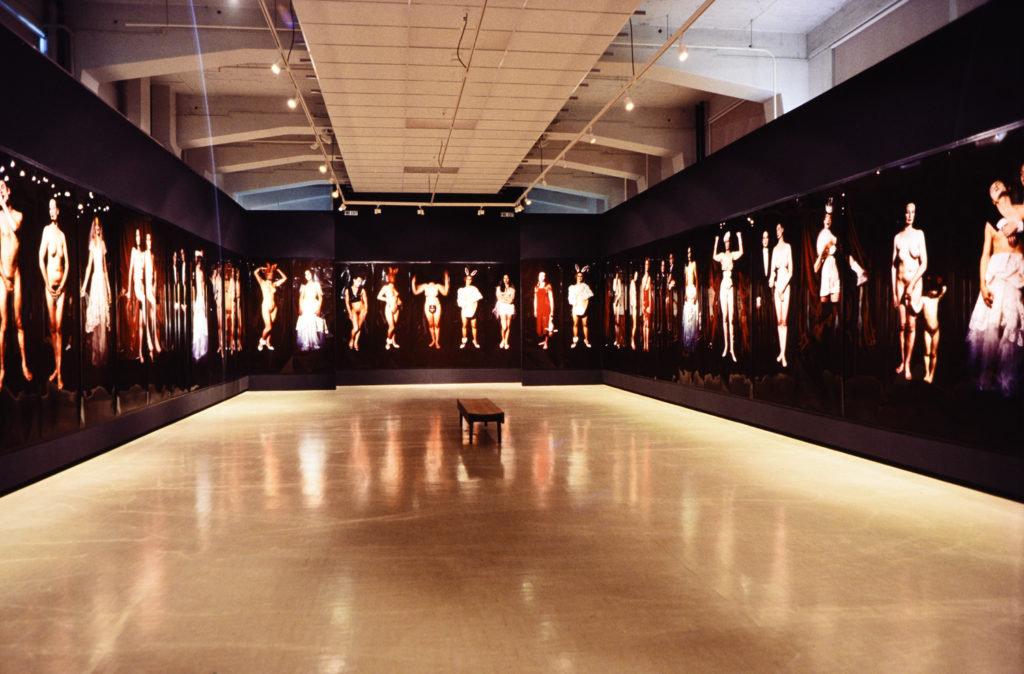ORGANISER Dunedin Public Art Gallery OTHER VENUES Dunedin Public Art Gallery, 3 December 1993–30 January 1994; Waikato Museum of Art and History, Hamilton, 6 February–20 March 1994; Govett-Brewster Art Gallery, New Plymouth, 2 April–15 May 1994; Robert McDougall Art Gallery, Christchurch, 19 May–2 July 1995; Auckland Art Gallery, 12 November 1995–28 January 1996; Queensland Art Gallery, Brisbane, 1996 SPONSOR Queen Elizabeth II Arts Council, Presentation Prints
In Christine Webster’s Black Carnival, larger-than-life photos of fancy-dressed figures encircle viewers in a dimly lit gallery. Photographed against black backgrounds, the figures seem to emerge from darkness. Hung edge-to-edge, the images form a fifty-metre-long frieze. There’s a soundtrack of ‘monkey-like laughter’.
Webster’s fresco-like work was inspired by a visit to the Villa of Mysteries in Pompeii. Webster combines its spectacle of Dionysian rituals, with elements of carnival, cabaret, masquerade, and nightclub dress-ups. Her images are full of perverse role play and gender bending. A semi-nude, red-lipped man lifts the lace of the wedding dress draped on his lower half, pulling away from a hand that emerges to restrain him. A masked woman in black stockings, shawl, and bustier poses before a red velvet curtain. Two nude men dance the cancan before the same curtain, masks hanging from their necks—one male, the other female. Etcetera.
Black Carnival makes innovative use of Cibachrome, the positive photographic printing paper known for its saturated colour and glossy finish. Webster says its mirror-like effect forces viewers to face their deviant voyeurism, as they are ‘caught in the act of observing a private ritual or performance’. She adds, ‘many of the figures are not self-absorbed but are actually scrutinising the audience’. In the Dominion Post, Louise Garrett observes, ‘The traditional male gaze that objectifies female form is averted. Here a new relationship develops between subject and viewer.’
The artist's opening floor talk proves popular. Auckland art historian Wendy Vaigro also presents an illustrated talk on carnival, femininity, and transgression.
‘By wielding the lofty rhetoric of the old processional frieze to the tawdry pleasures of a contemporary peepshow, Webster makes the chaste gallery crackle with sexual electrons’, writes Justin Paton in Flash Art. But, the show is not without its critics. In the Evening Post, James Mack says, ‘The mural installation is a good idea but suffers badly from overkill and overinterpretation.’ Despite the ‘the art-hysterical hype’, the show is ‘a bit of a let-down because it’s not raunchy enough or camp enough or pagan enough or titillating enough’.
Listener reviewer Nigel Yates has technical issues, suggesting the ‘increased contrast and colour shifts’ may be a result of original colour prints being copied ‘onto a larger film to avoid the excessive grain from too massive an enlargement of the original negative’. He goes on: ‘Two of the lifesize prints seem to be out of focus, surprising considering the prestige of the work. A more traditional worker would have chosen a much larger format camera to start with and aimed for finer print quality in the processing stage’.
Webster responds to her mansplainer, saying he ‘missed the point’ and that she ‘worked using a large format camera and went to great effort to achieve the deprocessed effect’. She concludes, ‘I am not trying to adhere to set conventions of photography—I merely use photography as a medium to achieve my desired effect … these sorts of misinterpretations are so disheartening and make me wonder why artists bother to stay in this country at all.’



















